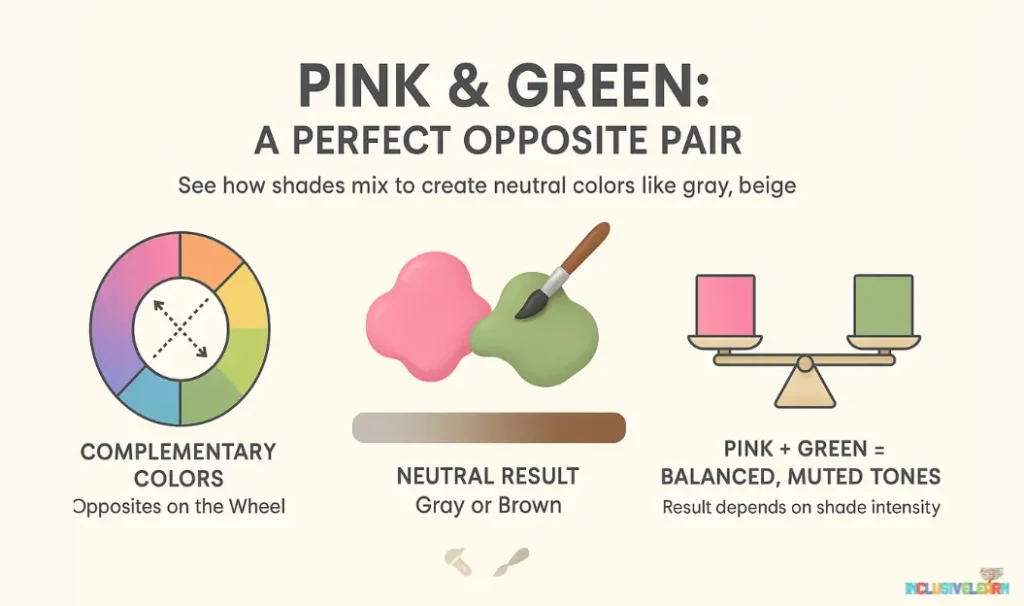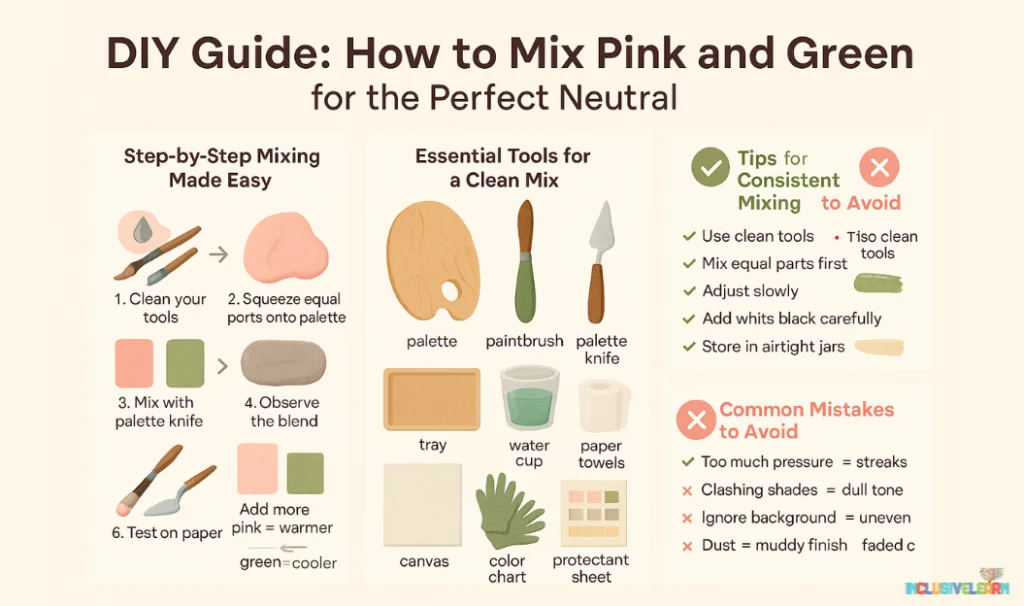🎨 Pink & Green Color Mixer
Pink and green make a neutral color. The color is usually gray or brown. However, the exact result depends on the specific shades you use. Light pink with mint green can create soft gray. On the other hand, dark green with hot pink may produce muddy brown. Therefore, understanding the interaction helps you use them better in art or design. Here is more on what color does pink and green make
Basic Color Theory: Pink and Green

Pink and Green Are Complementary Colors
Pink and green are complementary colors on the color wheel. They sit opposite each other. Therefore, they will cancel each other out when mixed. The balance creates a neutral shade like gray or brown. You can mix complementary colors to reduce the intensity. As a result, the final result looks muted rather than bright.
How Mixing Pink and Green Creates Neutral Tones?
When you mix complementary colors like pink and green, they cancel each other. In other words, they lose their brightness and create a neutral tone. Depending on the shades used, the tone can range from gray to brown. The balance between the two colors is what creates the muted effect.
Understanding Color Neutrality
Color neutrality means two opposing colors balance each other out. Pink and green, as opposites, cancel out in a neutral color. They have all the primary colors. The final shade depends on the specific pink and green used. You will create gray, brown, or something in between.
Mixing Pink and Green: Paint vs. Digital
Are you wondering what color does pink and green make? You get a neutral color like gray or brown because the pigments blend physically. However, the final shade depends on the paint type, brand, and proportions. Water-based paint may look different from oil-based paint because of their different mixing qualities.
However, RGB or CMYK mixes pink and green differently. RGB (screens) uses light, so pink and green can create unexpected colors. However, CMYK uses ink to produce neutral shades. The system you use changes the result. RGB can look brighter. In contrast, CMYK gives an accurate result.
The Effect of Different Shades of Pink and Green
The result of mixing pink and green changes with shades. You can mix light pink and mint green to create a soft gray. It is perfect for gentle designs and at-home projects. In contrast, dark green and hot pink form a muddy brown. The color is ideal for bold art that demands attention.
Simple DIY Guide for Mixing Pink and Green

Step-by-Step Mixing Instructions
- First, start with clean tools to avoid mixing colors you do not want together.
- Next, choose your pink and green shades based on your desired result.
- Now use a palette for mixing.
- Squeeze equal amounts of pink and green onto the palette.
- You can mix the colors with a palette knife for even blending.
- Observe the resulting color to get a neutral tone.
- Adjust by adding more pink for a warmer tone. You can add green for a cooler shade.
- Test the color on scrap paper for accuracy.
- Finally, adjust until you achieve the perfect gray or brown shade.
- Lastly, clean your tools immediately to avoid dried paint.
Basic Tools with Their Usage
- Palette will hold your paint for mixing and blending.
- Brush applies and blends colors smoothly on surfaces.
- You can use a knife to mix paint colors evenly without wasting paint.
- Keep a water cup near you to clean brushes between different colors easily.
- Also, a tray will separate colors for controlled mixing.
- Use paper towels to wipe brushes and correct mistakes instantly.
- Moreover, wear gloves to protect your hands from paint and stains.
- A canvas will provide a surface for your mixed colors.
- A color chart will help you match and identify colors.
- Lastly, use a protectant sheet to keep surfaces safe.
Tips for Consistent Color Mixing
- Always use clean tools to avoid mixing unwanted colors.
- Mix equal parts first to maintain balanced colors.
- Next, adjust shades slowly for precise color control.
- Add white to lighten colors without losing brightness.
- Use black carefully to darken colors subtly.
- Also, you can stir colors for even blending.
- Store mixed colors in airtight containers. It will keep the tone fresh.
Common Mistakes
- Do not use too much pressure. It causes streaks in the final color.
- Also, using clashing shades makes neutral colors look unappealing.
- Do not forget about the background. Otherwise, blending is uneven.
- Applying too little paint results in uneven color coverage.
- Next, mixing in a dusty area affects the final color.
- You must adjust according to the texture to avoid wrong blending results.
- Remember the dry time. Otherwise, you will notice messy and blurred colors.
- Lastly, avoid too much water. It will dilute colors with a very weak hue.
Addressing the Common Myth About Purple
Pink and green do not make purple. They create neutral shades like gray or brown. The myth exists because people confuse pink with red.
Moreover, red is a primary color. Since red and blue make purple, people assume pink would do the same. Many people think pink is the same as light red.
To create purple, you need red and blue. The two primary colors mix directly to produce purple. Also, pink and red are not the same. It will not work because mixing lacks the necessary blue intensity.
Using Pink and Green Together Without Mixing
Pink and green can look stunning together without mixing. Designers use contrast for vibrant and eye-catching designs. Light pink with mint green feels soft and fresh. In contrast, hot pink with dark green looks bold. The combination works well in fashion, home decor, and graphic design. It creates a balanced and dynamic look. More on that later!
Sample Color Combinations and Palettes
Soft pink with mint green creates a calm and refreshing look. It is perfect for baby rooms and designs that celebrate spring. Also, bright pink with vibrant lime green gives an energetic look. The hue is ideal for summer designs and beachwear. The combination is cheerful and eye-catching. Therefore, adjusting the amount of pink or green can shift the color. Adding more pink makes it warm. However, introducing more green mutes the shade.
Who Will Find the Information Useful?
- Artists understand what color does pink and green make. Use the knowledge to achieve balanced shades. They avoid color mixing mistakes in the paintings.
- Designers create visually appealing palettes using pink and green. They use contrast for standout designs in fashion and branding projects.
- DIY Decorators experiment with pink and green for unique home designs. They test the shade for wall colors and accents. As a result, they can achieve soft or bold looks in any space.
- Teachers explain what color does pink and green make. They use basic color theory to teach students about using colors. The final shade is very surprising. It makes learning fun and practical.
FAQ: What Color Does Pink and Green Make?
Can pink and green make beige?
Balanced and muted shades of pink and green create a beige tone.
Do they always create gray or brown?
Not always. The final result depends on the shades and the measurements. Light tones may create beige or gray.
What happens if you add white or black?
You can add white to lighten the mixed color. On the other hand, adding black will darken it. However, you can adjust the shade without changing its base tone.
Can pink and green make a warm color?
Use warm pink and green shades, and the result is a warm color. It will look beige or peach.
The Takeaway
Pink and green usually create neutral colors like gray or brown. In other words, they cancel out the brightness. Therefore, understand the shades to create balanced palettes and avoid color mistakes. You can design better. Now, experiment with the colors for creative projects. You can answer what color does pink and green make confidently.


